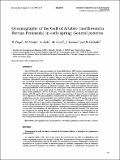Por favor, use este identificador para citar o enlazar a este item:
http://hdl.handle.net/10261/25642COMPARTIR / EXPORTAR:
 SHARE
BASE SHARE
BASE
|
|
| Visualizar otros formatos: MARC | Dublin Core | RDF | ORE | MODS | METS | DIDL | DATACITE | |

| Título: | Oceanography of the Gulf of Artabro (northwestern Iberian Peninsula) in early spring: General patterns |
Otros títulos: | Oceanografía del golfo de Artabro (noroeste de la península Ibérica) a principios de la primavera: modelo general | Autor: | Prego, R. CSIC ORCID ; Varela, Manuel; Bode, Antonio CSIC ORCID CVN; Canle, M.; Lorenzo, J.; Carballo, R. | Palabras clave: | Hydrography Front Spring bloom Chlorophyll Plankton Gulf of Artabro Galicia Hidrografía Frente Proliferación primaveral Clorofilas1 Golfo de Artabro |
Fecha de publicación: | 1999 | Editor: | Instituto Español de Oceanografía | Citación: | Boletín del Instituto Español de Oceanografía 15 (1-4): 73-79 (1999) | Resumen: | [EN] The COPLA 393 cruise was carried out from 22-29 March 1993 on the continental shelf located
between the Sisargas Islands and Cape Prior (northwest Spain). Forty-one stations distributed
into five sections perpendicular to the coast were sampled, with the aim of investigating
spring conditions in the Gulf of Artabro. Salinity and temperature profiles were obtained, and
nutrients, chlorophyll, primary production, light, specific composition and abundance of plankton
(including bacteria and phytoflagellates) were determined. The present study provides the
first survey of conditions prevailing at the beginning of the spring in the entire Gulf of Artabro.
The hydrographic situation is relatively complex, with a quite well defined thermic-saline
front perpendicular to the coastline in the central part of the Gulf of Artabro. The water west of
the frontal area was more saline (13.2 °C; 35.85 psu), whereas east of the front colder and less
saline waters prevailed (12.8 °C; 35.75 psu). When the cruise was carried out, the primary production
(35-155 mg C m–2 h–1) and chlorophyll a concentration (< 2 mg m–3) were relatively low
and a dispersion of the phytoplankton communities was observed. Mean biomass of the microzooplankton
and the mesozooplankton were typical of winter (8.8 and 23 mg dw, respectively).
Bacteria (1.5 105 cel ml–1) and microflagellates (phytoflagellate autotrophs: 790 cel ml–1 and
heterotrophs: 960 ml–1) also had low abundances. The atmospheric conditions, which favoured
an early spring bloom in February, had changed. There were areas with phytoplankton typical of
winter, with predominance of microflagellates, cryptophyceae and small dinoflagellates, and other
areas with low abundance of phytoplankton but with a high specific diversity. The latter were
the remains of the spring bloom, which had occurred some days before the beginning of the
cruise. Therefore, we suggest that the bloom-dispersion regime may be a common feature, existing
normally in this gulf, as a consequence of the occurrence of early blooms in winter and
the varying environmental conditions in the February-March period. [ES] La campaña COPLA 393 se llevó a cabo entre el 22 y el 29 de marzo de 1993 en la plataforma continental comprendida entre las islas Sisargas y el cabo Prior. Se muestrearon 41 estaciones distribuidas en cinco secciones perpendiculares a la costa. Su objetivo fue investigar las condiciones hidrográficas y la floración de primavera en el golfo de Artabro. Se obtuvieron perfiles de salinidad y temperatura, datos de nutrientes, clorofila, producción primaria, luz incidente, composición específica y cuantificación del plancton (incluyendo bacterias y fitoflagelados). Su estudio ha proporcionado, por primera vez en la totalidad del golfo de Artabro, información acerca de las condiciones reinantes al comienzo de la primavera. La situación hidrográfica es relativamente compleja, con un frente térmico y salino bastante bien definido perpendicular a la línea de costa en la parte central del golfo de Artabro. Hay agua más salina al oeste (13,2 °C; 35,85 ups) de la zona frontal y al este un cuerpo de agua más fría y de menor salinidad (12,8 °C y 35,75 ups). Cuando se llevó a cabo la campaña, la producción primaria (35-155 mg C m–2 h–1) y la concentración de clorofila a (< 2 mg m–3) eran bajas y se observa una dispersión de las comunidades de fitoplancton. Tanto el microzooplancton como el mesozooplancton presentan biomasas medias típicas de invierno (8,8 y 23 mg de peso seco, respectivamente). También bacterias (1,5 105 células ml–1) y microflagelados (fitoflagelados autótrofos: 790 células ml–1 y heterótrofos: 960 células ml–1) mostraron bajas abundancias. Las condiciones atmosféricas que favorecieron una temprana proliferación primaveral de fitoplancton en febrero habían cambiado. Hay zonas con fitoplancton propio del invierno, con predominio de microflagelados, criptofíceas y pequeños dinoflagelados junto con otras de baja abundancia de fitoplancton, pero una alta diversidad específica. Son los restos de la floración primaveral que tuvo lugar días antes del comienzo de la campaña. Por ello, el régimen proliferación-dispersión debe darse corrientemente en este golfo como consecuencia de la proliferación temprana y de las cambiantes condiciones ambientales en febrero-marzo. |
Descripción: | 7 pages, 5 figures, 2 tables.-- In Oceanography of the Atlantic Iberian Continental Margin: 2nd Symposium on the Atlantic Iberian Continental Margin (Cadiz, Spain, September 17-20, 1997). | Versión del editor: | http://www.ieo.es/publicaciones/boletin/pdfs/bol15/15_073-079.PDF | URI: | http://hdl.handle.net/10261/25642 | ISSN: | 0074-0195 |
| Aparece en las colecciones: | (IIM) Artículos |
Ficheros en este ítem:
| Fichero | Descripción | Tamaño | Formato | |
|---|---|---|---|---|
| 15_073-079.pdf | 251,56 kB | Adobe PDF |  Visualizar/Abrir |
CORE Recommender
Page view(s)
328
checked on 23-abr-2024
Download(s)
124
checked on 23-abr-2024
Google ScholarTM
Check
NOTA: Los ítems de Digital.CSIC están protegidos por copyright, con todos los derechos reservados, a menos que se indique lo contrario.
